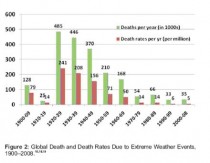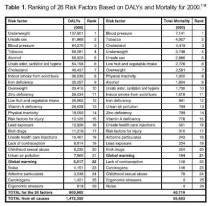Joseph D’Aleo, CCM, AMS Fellow
The EPA’s Lisa Jackson in her opening statement in front of congress this week said:
“Based on the best peer-reviewed science, EPA found in 2009 that manmade greenhouse gas emissions do threaten the health and welfare of the American people.” [THIS IS A REFERENCE TO the DECEMBER 2009 Endangerment Finding: see links BELOW to select comments submitted to the EPA]
Lynn Goldman of the APHA in testimony stated the following:
“Climate change is already dramatically affecting the health of people around the world especially in the developing world. According to the World Health Organization, an estimated 166,000 deaths and about 5.5 million disability-adjusted life years (DALYs, a measure of overall disease burden) were attributable to climate change in 2000.”
And concluded:
“Growing scientific consensus shows us that the climate is changing in ways that increasingly affect the health of people around the world. Because climate influences how people live, breathe and eat as well as the availability of water, populations everywhere, including the United States, may already be experiencing the health impacts of these changes. This is especially true among our most vulnerable populations, children, the elderly and the poor.
We cannot afford to delay or ignore addressing the health impacts of climate change.”
Reality Check:
Dr. Indur Goklany in Global public health: Global warming in perspective. Journal of American Physicians and Surgeons 14 (3): 69-75 (2009) responded to the quoted report.
“The methodology used in the WHO reports (Table 1 below, enlarged) to estimate mortality (and burden of disease) from global warming essentially is to assign fractions of deaths occurring from real causes (e.g., diarrhea and malaria) to hypothesized underlying risk factors (e.g., global warming). Thus, malnutrition (hunger) accounted for 52% of the DALYs attributed to global warming; diarrhea (from food and waterborne disease), 26%; malaria, 18%; flooding, 3%. In addition to 154,000 deaths in 2000 from diarrhea, malaria, dengue, flooding, and malnutrition assumed to result from climate change (global warming), the study from which this estimate was obtained added 12,000 deaths from presumed climate-change-induced cardiovascular disease. This estimate of 166,000 deaths in 2000 attributable to global warming was also the basis for the estimate provided in a 2005 review article in, which was then picked up and repeated in various influential publications.
But these estimates are inherently uncertain, not least because, as noted by the researchers who developed them: Climate change occurs against a background of substantial natural climate variability, and its health effects are confounded by simultaneous changes in many other influences on population health. Empirical observation of the health consequences of long-term climate change, followed by formulation, testing and then modification of hypotheses would therefore require long time-series (probably several decades) of careful monitoring. While this process may accord with the canons of empirical science, it would not provide the timely information needed to inform current policy decisions on GHG emission abatement, so as to offset possible health consequences in the future.
That is, the analysis was guided more by the need to satisfy a policy agenda than rigorous scientific methodology. As a result, as the above quotation implicitly acknowledges, the estimates for global warming are based on, at best, poorly validated models.”
And in Deaths and Death Rates from Extreme Weather Events: 1900-2008. Journal of American Physicians and Surgeons 14 (4): 102-09 (2009), he shows global death and death rates declining (below, enlarged).

In the study he concludes: “Current deaths and death rates from extreme weather events for both the U.S. and the globe are, in general, lower than in previous decades. Predictably, annual death rates have declined more rapidly than annual deaths, confirming results from previous studies. This indicates that the total risk of death from such events has actually declined, notwithstanding any increases in the number or intensity of extreme weather events that some claim to have occurred. Globally as well as for the United States, the aggregate contribution of extreme weather events to the mortality burden is currently minor - on the order of 0.06%.”
Also see:
Discounting the Future, Regulation 32: 36-40 (Spring 2009).
Is Climate Change the “Defining Challenge of Our Age”? Energy & Environment 20(3): 279-302 (2009).
Here are some of the comments filed to the EPA on their endangerment finding. Here was a submission that combined many different comments I made to the EPA. Here also is a powerful letter to the EPA signed by 35 scientists that challenged the science used in making their endangerment finding on 18 major points.



